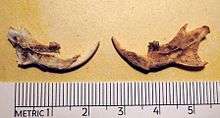Rhagamys
| Rhagamys | |
|---|---|
 | |
| Scientific classification | |
| Kingdom: | Animalia |
| Phylum: | Chordata |
| Class: | Mammalia |
| Order: | Rodentia |
| Family: | Muridae |
| Subfamily: | Murinae |
| Genus: | †Rhagamys Major, 1905 |
| Species: | †R. orthodon |
| Binomial name | |
| Rhagamys orthodon Hensel, 1856 | |
Rhagamys is an extinct genus of rodents in the subfamily Murinae, the Old World mice and rats. The genus was established by the Swiss zoologist Charles Immanuel Forsyth Major to accommodate Rhagamys orthodon, commonly known as Hensel's field mouse or the Tyrrhenian field rat, which is the only species in the genus. It was endemic to the Mediterranean islands of Corsica and Sardinia, where it first appeared in the fossil record in the Late Pleistocene, and was relatively large in size, weighing up to 50 g.[1]
Taxonomy and evolution
Fossils of another species, originally identified as Rhagamys minor, and dating back to the early and middle Pleistocene, are also found on Corsica and Sardinia, but this species has been reallocated to Rhagapodemus. Rhagamys orthodon seems to be most closely related to Rhagapodemus and to the field mice (Apodemus). Its molars are similar to those of the wood mouse (Apodemus sylvaticus) and the striped field mouse (Apodemus agrarius) but are larger and more derived, being hypsodont teeth suitable for feeding on a coarse, abrasive diet.[1] Over time, Rhagamys orthodon increased in size and became larger than the broad-toothed field mouse (Apodemus mystacinus).[2]
History
Before the arrival of man on the islands in about 6500 BC, Corsica and Sardinia had their own endemic fauna which besides Rhagamys orthodon included Hensel's vole (Microtus henseli), the Sardinian pika (Prolagus sardus), two large shrews (Episoriculus), one on each island, a mole (Talpa tyrrhenica), the Sardinian dhole (Cynotherium sardous), an otter (Algarolutra majori) and a small deer (Megaloceros cazioti). The deer soon died out but the other species co-existed with man until the first millennium AD. They later became extinct and this may have been due to the cutting down of the natural forests and the change in land use to agriculture, but it may also be associated with the introduction of the black rat (Rattus rattus).[1] The Sardinian pika was the last remaining terrestrial endemic mammal, surviving on the outlying island of Tavolara until 1774, having become extinct on the main island several centuries earlier. The only endemic mammal still found on the islands is the Sardinian long-eared bat (Plecotus sardus).[3][4]
References
- 1 2 3 Musser, G.G.; Carleton, M.D. (2005). "Superfamily Muroidea". In Wilson, D.E.; Reeder, D.M. Mammal Species of the World: A Taxonomic and Geographic Reference (3rd ed.). Johns Hopkins University Press. pp. 1496–1497. ISBN 978-0-8018-8221-0. OCLC 62265494.
- ↑ Alexandra van der Geer; George Lyras; John de Vos; Michael Dermitzakis (2011). Evolution of Island Mammals: Adaptation and Extinction of Placental Mammals on Islands. John Wiley & Sons. p. 124. ISBN 978-1-4443-9128-2.
- ↑ Mucceda, M.; Kiefer, A.; Pidincedda, E.; Veith, M. (2002). "A new species of long-eared bat (Chiroptera, Vespertilionidae) from Sardinia (Italy)". Acta Chiropterologica. 4: 121–135. doi:10.3161/001.004.0202.
- ↑ Amori,Giovanni; Gippoliti, Spartaco; Luiselli, Luca (2013). "A short review of the roles of climate and man in mammal extinctions during the Anthropocene". Anthropocene—Natural and man-made alterations of the Earth’s fragile equilibrium. doi:10.1007/s12210-013-0240-6.